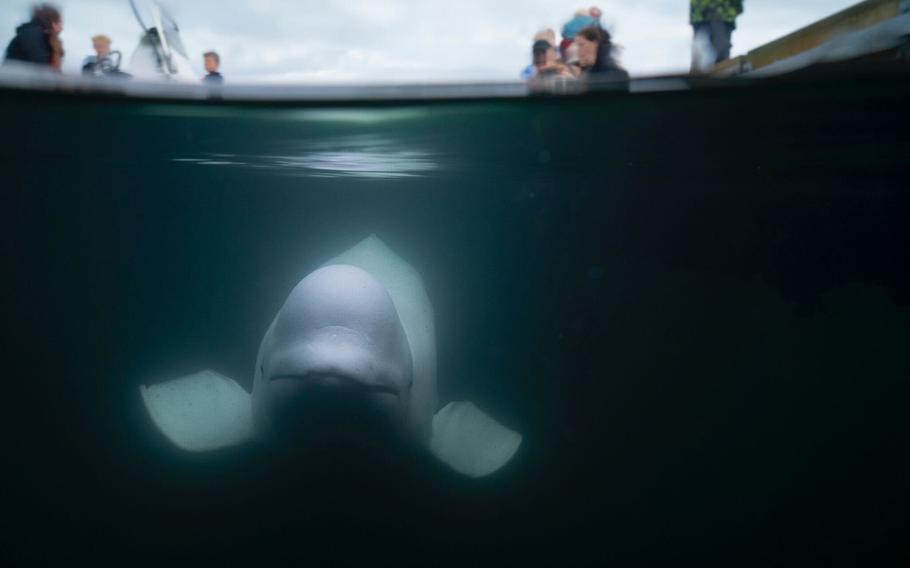
Hvaldimir was found dead in Norway's Risavika Bay on Saturday. (Courtesy of Marine Mind)
A beluga whale suspected of being a Russian intelligence asset — before winning the hearts of Norwegian fishermen with his toothy grin — was found dead over the weekend. The mammal, affectionately known as “Hvaldimir,” was estimated to be 14 to 17 years old.
“He was sociable, playful and fond of humans,” said marine biologist Sebastian Strand, who said he saw the animal’s white body floating motionlessly in Norway’s Risavika Bay on Saturday afternoon. “It’s far younger than we had hoped,” he said in a telephone interview, noting that belugas typically live more than 30 years.
Hvaldimir’s cause of death is unknown. Port officials transported his body to a cooling facility after it was found, and it “is undergoing an autopsy as we speak,” Olav Lekve, a spokesman for Norway’s fisheries directorate, wrote in an email Monday. The results will be ready in several weeks, he said.
The suspected intelligence asset captured global attention five years ago, when he approached Norwegian fishermen while strapped in a harness that read, “Equipment St. Petersburg.” Locals nicknamed him “Hvaldimir,” a playful combination of the Norwegian word for whale, hval, and Russian President Vladimir Putin’s first name.
While the beluga whale may have initially found himself ensnared in Russia’s geopolitical rift with the West, Strand — who is head of the advocacy group Marine Mind and has tracked Hvaldimir’s movements for years — said he found his calling as an “ambassador between species.”
“He did by every likelihood come from Russia; that was the source of his initial fame,” Strand said. “But over the years, the individual that he was, the way that he carried himself, his fondness for people, grew over that. I think people knew him more as ‘Hvaldimir’ than as the Russian spy.”
If Hvaldimir was trained by Russian handlers for a career in subterfuge, he was not very good at it. By all accounts, Hvaldimir spent his days craving attention wherever he could find it. “He was playful, and he was fond of humans. He would seek out contact with them,” Strand said. “Quite often, we would see him splash his fins across the water or aim his blow toward children to incite laughter.”
He also traveled widely: After sticking around Norway’s peaceful northern Finnmark region, which borders Russia, he ventured to more populous coastal areas and even paid a visit to Sweden.
Researchers speculated that the harness Hvaldimir was initially discovered wearing could have carried weapons or cameras, raising suspicions that he was a remnant of a Russian navy program that was purportedly seeking to train aquatic mammals as spies. Moscow’s Defense Ministry has denied such a program exists but once published an ad offering $24,000 for five bottlenose dolphins.
The exact function of Hvaldimir’s harness remains unclear. “We might never know with 100 percent certainty what his past entailed,” Strand said.
The Pentagon has recruited sea mammals for military purposes since the 1950s. The U.S. Navy says it uses dolphins and sea lions to locate mines, retrieve objects from the ocean floor and gather intelligence, but not for offensive operations.
Strand said he spotted Hvaldimir’s body during a routine visit to the waters where people had submitted sightings of the whale — as, he said, he has done most days for the past three years. “Upon approach, I saw something white. … It didn’t move like Hvaldimir,” he said. “When we found him, there was no immediately obvious cause of death.”
Regina Crosby Haug, a filmmaker whose organization, OneWhale, has advocated for Hvaldimir since 2019, said: “He didn’t have a fear of humans in the way that a beluga whale in the wild would have.”
“There’s a reason why animals have to have an inherent fear of humans and human activity. It’s because our world is a dangerous one for them,” she added in a phone interview Monday.
Crosby Haug, who was campaigning to relocate Hvaldimir to calmer Arctic waters for his safety, said she had secured official permits in June to move him. “It’s a terrible situation and a horrible ending to a long battle for his life,” she said.
Hvaldimir’s unusual behavior in approaching humans and their boats may have stemmed from his need for companionship as a lone whale. “That need is so strong that they come right up to boats, as they are attracted by sounds and by motors,” Catherine Kinsman, an expert in solitary whales, told The Washington Post in 2019.
But as well as making Hvaldimir friendly to humans, those needs may have made him vulnerable. At the time, Kinsman said the fact that he was cared for by humans could make him dependent on being fed by others, and his need for companionship attracted him dangerously close to boats.
“He was an animal that took the hearts of many, many thousands of people,” Strand said. “I’ll be far from alone in mourning him.”
Bryan Pietsch, Rick Noack and Karin Brulliard contributed to this report.